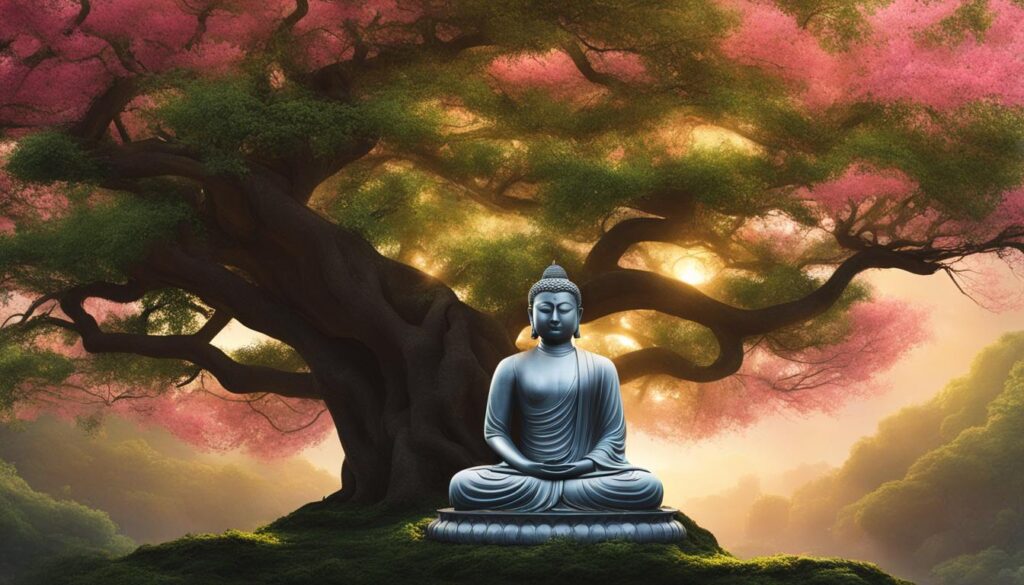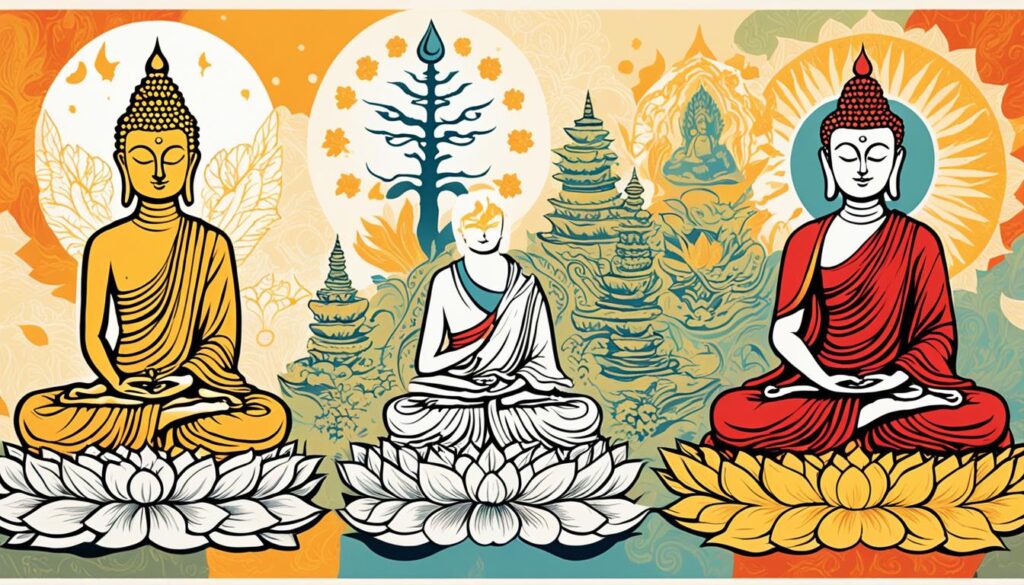Have you ever wondered how Buddhism, one of the world’s major religions, came into existence? What were the circumstances that led to the founding of this ancient faith? The origins of Buddhism reveal a fascinating journey of self-discovery, enlightenment, and a profound desire to end suffering. Let’s dive into the depths of history and explore the intriguing beginnings of Buddhism.
Key Takeaways:
- Buddhism was founded by Siddhartha Gautama, also known as “the Buddha,” over 2,500 years ago in India.
- It is a non-theistic faith focused on achieving enlightenment and inner peace.
- The path to enlightenment involves morality, meditation, and wisdom.
- After his enlightenment, Gautama dedicated his life to teaching others about spiritual awakening.
- Over time, Buddhism evolved into various schools or types, including Theravada, Mahayana, and Tibetan Buddhism.
The Beliefs and Practices of Buddhism
Buddhism is a profound and ancient religion that encompasses a unique set of beliefs and practices. Unlike other religions, Buddhism does not worship a supreme god or deity. Instead, Buddhism focuses on individual enlightenment and the pursuit of inner peace and wisdom.
The path to enlightenment in Buddhism involves three core elements: morality, meditation, and wisdom. By following these practices, individuals can attain a state of profound understanding and liberation from suffering.
Buddhism is a tolerant and evolving religion with various philosophies and interpretations. It encourages individuals to strike a balance between self-indulgence and self-denial, emphasizing the importance of cultivating mindfulness and compassion.
At the center of Buddhism’s teachings are The Four Noble Truths, which form the cornerstone of the religion. These truths provide insight into the nature of suffering, its causes, and the path to liberation from suffering. Understanding and reflecting upon these truths is crucial for anyone seeking a deeper understanding of Buddhism and its fundamental principles.
Karma and reincarnation are also central concepts in Buddhism. Karma refers to the belief that our actions have consequences, shaping our present and future experiences. Reincarnation, on the other hand, suggests that individuals are reborn into new lives based on their accumulated karma. This belief in the cycle of birth, death, and rebirth underscores the Buddhist belief in the impermanence of existence.
To illustrate the core beliefs and practices of Buddhism, refer to the following table:
| Beliefs | Practices |
|---|---|
| The pursuit of enlightenment and inner peace | Morality, meditation, and wisdom |
| Non-theistic perspective | Self-reflection and mindfulness |
| The Four Noble Truths | Studying and contemplating Buddhist scriptures |
| Karma | Engaging in acts of compassion and kindness |
| Reincarnation | Regular meditation practice |
In conclusion, Buddhism’s beliefs and practices revolve around the pursuit of enlightenment, inner peace, and wisdom. This non-theistic religion emphasizes the importance of moral behavior, meditation, and the cultivation of wisdom to uncover the true nature of reality. By understanding the core teachings of Buddhism, individuals can embark on a transformative journey towards personal and spiritual growth.

The Founder of Buddhism
Siddhartha Gautama, the founder of Buddhism, lived during the 5th century B.C. Born into a wealthy family in present-day Nepal, Gautama was deeply moved by the suffering he witnessed in the world. In search of truth and enlightenment, he renounced his luxurious lifestyle, leaving behind his palace and loved ones.
For six years, Gautama immersed himself in spiritual practices, seeking answers to the fundamental questions of life. Ultimately, it was while meditating under a Bodhi tree that he attained enlightenment. This profound experience revealed to Gautama the true nature of suffering and the path to liberation.

Following this illumination, Gautama dedicated the rest of his life to sharing his insights with others. He traveled throughout India, teaching and guiding people from all walks of life on the path to nirvana, or enlightenment.
After Gautama’s eventual passing, his disciples carried forth his teachings, organizing a community of followers and establishing Buddhism as a distinct religion. The life of the Buddha, Siddhartha Gautama, serves as the foundation for the philosophy and practices that embody the essence of Buddhism.
The Development and Types of Buddhism
After Siddhartha Gautama’s death, Buddhism spread beyond India and began to evolve into different schools or types. These diverse forms of Buddhism emerged to meet the unique cultural and spiritual needs of different regions and communities. Each type of Buddhism has its own distinct practices, beliefs, and teachings. Let’s explore three prominent types of Buddhism: Theravada Buddhism, Mahayana Buddhism, and Tibetan Buddhism.
Theravada Buddhism
Theravada Buddhism, also known as the “Doctrine of the Elders,” is most prevalent in Southeast Asia, including countries like Thailand, Sri Lanka, Cambodia, Laos, and Burma. It is considered the oldest surviving branch of Buddhism and strictly follows the original teachings of the Buddha. Theravada Buddhists strive for individual liberation and enlightenment through meditation, mindfulness, and morality. This branch emphasizes the importance of studying the scriptures and adhering to the monastic code of conduct.
Mahayana Buddhism
Mahayana Buddhism, developed about four centuries after the birth of Buddhism, gained popularity and influenced most of today’s Buddhist practices worldwide. This branch emphasizes compassion, wisdom, and the desire to lead others toward liberation. Mahayana Buddhists believe in the existence of Bodhisattvas, enlightened beings who postpone their own liberation to assist others on their path to enlightenment. Mahayana Buddhism is practiced in East Asia, including China, Japan, Korea, and Vietnam.
Tibetan Buddhism
Tibetan Buddhism is predominantly followed in Tibet, Nepal, Mongolia, Bhutan, and parts of Russia and northern India. It encompasses a rich blend of indigenous Tibetan beliefs and Buddhist philosophies. Tibetan Buddhists emphasize rigorous meditation practices, complex rituals, and the cultivation of compassion and wisdom. Tibetan Buddhism is also known for its unique spiritual leaders, such as the Dalai Lama, who holds a prominent role in guiding and inspiring practitioners.
Other notable forms of Buddhism include Zen Buddhism, which is a branch of Mahayana Buddhism that focuses on simplicity and meditation, and Pure Land Buddhism, which emphasizes devotion to Amida Buddha and the aspiration to be reborn in a Pure Land.
Each type of Buddhism offers its followers a distinct path towards enlightenment and spiritual growth. The development of these various schools showcases the adaptability and resilience of Buddhism as it spread across different cultures and regions, resonating with people’s spiritual yearnings.
| Type of Buddhism | Main Regions | Key Beliefs and Practices |
|---|---|---|
| Theravada Buddhism | Thailand, Sri Lanka, Cambodia, Laos, Burma | Individual liberation, meditation, mindfulness, and adherence to monastic code |
| Mahayana Buddhism | China, Japan, Korea, Vietnam | Compassion, wisdom, leading others to liberation, belief in Bodhisattvas |
| Tibetan Buddhism | Tibet, Nepal, Mongolia, Bhutan, parts of Russia and northern India | Meditation, complex rituals, compassion, wisdom, indigenous Tibetan beliefs |

Conclusion
Buddhism’s impact extends far beyond meditation and mindfulness practices. Its timeless teachings offer profound insights for personal and societal harmony, fostering compassion, kindness, and wisdom within individuals and communities. With its origins dating back over 2,500 years, Buddhism continues to resonate in the modern world, offering guidance to address contemporary challenges and leading to a more fulfilling and meaningful life.
By delving into the origins of Buddhism and understanding the profound teachings of its founder, Siddhartha Gautama, you can tap into the wisdom that has guided millions of followers throughout history. Buddhism’s influence is not limited to the East, as its principles have spread across the globe, shaping diverse cultures and inspiring individuals to cultivate inner peace, empathy, and spiritual growth.
Embarking on a spiritual journey through Buddhism allows you to uncover the lasting impact of its teachings. Its emphasis on personal enlightenment and the relief of suffering extends beyond religious boundaries, offering insights and practices that resonate with people from all walks of life. As you explore Buddhism’s rich heritage and timeless wisdom, you will discover how its teachings can bring about personal transformation and foster harmony within yourself and society as a whole.
FAQ
Who founded Buddhism?
Buddhism was founded by Siddhartha Gautama, also known as “the Buddha,” over 2,500 years ago in India.
How did Buddhism start?
Buddhism started when Siddhartha Gautama renounced his luxurious lifestyle and sought a life without indulgences or deprivation. After finding enlightenment while meditating under a Bodhi tree, he dedicated his life to teaching others how to achieve this spiritual state.
What are the beliefs and practices of Buddhism?
Buddhism is a non-theistic faith focused on achieving enlightenment and inner peace. It revolves around the concept of suffering and its causes and emphasizes morality, meditation, and wisdom as the path to enlightenment. Buddhism encourages individuals to avoid both self-indulgence and self-denial.
Who did Buddhism appeal to?
Buddhism appeals to individuals seeking enlightenment and inner peace. It offers insights for personal and societal harmony, promoting qualities such as compassion, kindness, and wisdom.
Who is the founder of Buddhism?
The founder of Buddhism is Siddhartha Gautama, also known as “the Buddha.”
How did Siddhartha Gautama become enlightened?
Siddhartha Gautama became enlightened while meditating under a Bodhi tree. After six years of searching, he found the state of inner peace and wisdom that became the foundation of Buddhism.
What are the types of Buddhism?
There are different types of Buddhism. Theravada Buddhism is prevalent in Thailand, Sri Lanka, Cambodia, Laos, and Burma. Mahayana Buddhism, which emphasizes compassion and the desire to lead others toward liberation, has influenced most of today’s Buddhist practices worldwide. Tibetan Buddhism developed in Tibet, Nepal, Mongolia, Bhutan, and parts of Russia and northern India. Zen Buddhism, a form of Mahayana Buddhism, focuses on simplicity and meditation.
What is Buddhism’s impact?
Buddhism’s impact goes beyond meditation and mindfulness practices. Its teachings offer insights into personal and societal harmony, promoting qualities such as compassion, kindness, and wisdom. Buddhism’s timeless wisdom continues to resonate today, addressing modern challenges and providing guidance for leading a fulfilling and meaningful life.

